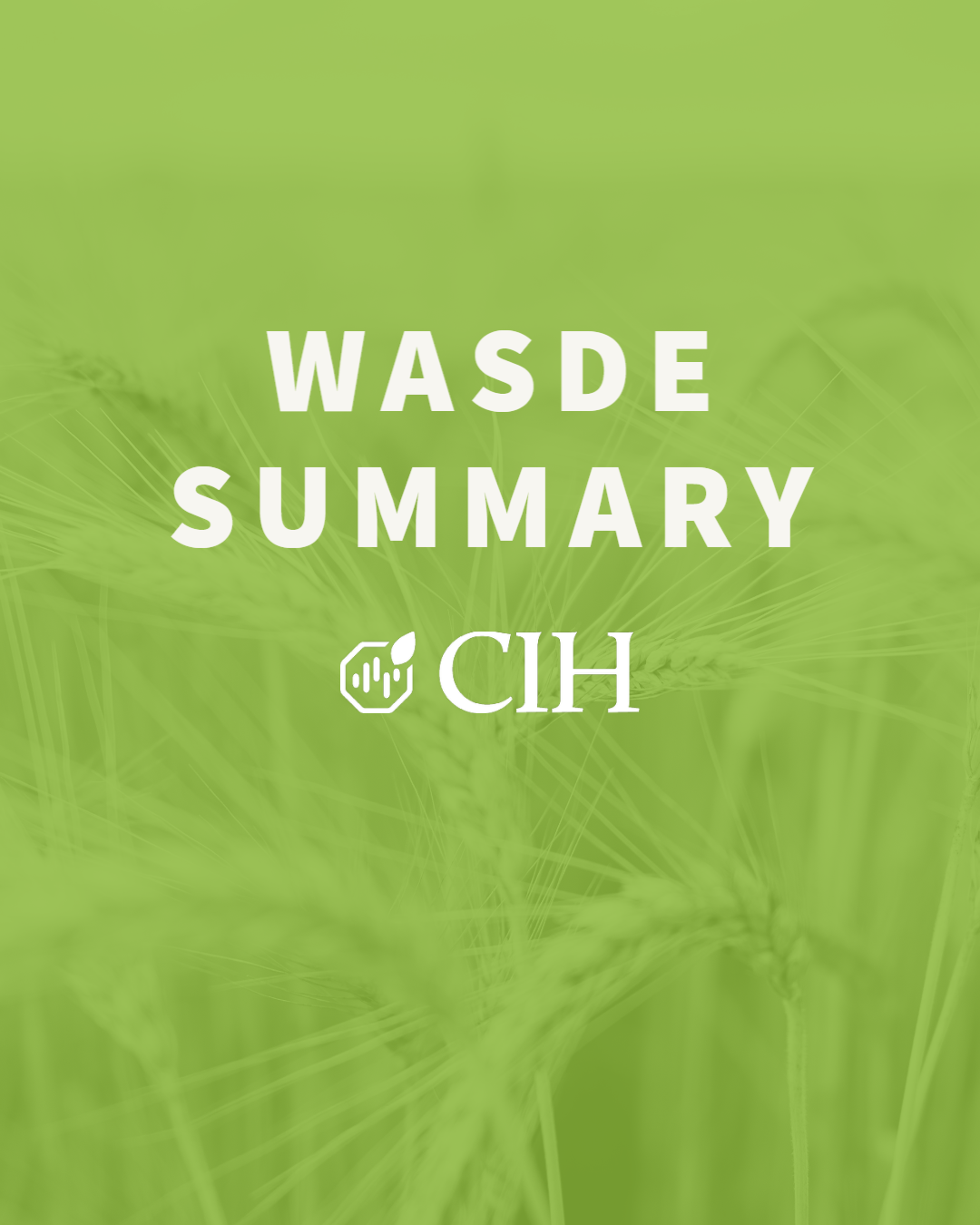
January 12, 2024
JANUARY 2024 WASDE REPORT SUMMARY & NOTES:
The January WASDE report was viewed as relatively bearish for corn, soybeans, and wheat as global ending stocks were increased for all three commodities despite much discussion on the impact of South American weather on yield potential. This report finalizes 2023/24 U.S. row crop production numbers.
The 2023/24 corn balance sheet called for greater production and higher ending stocks. Production was increased by 108 million bushels from last month as an increase in yield (to a record-high 177.3 bushels per acre) outweighed a slight reduction in harvested acres. Pegged at 15.3 billion bushels, this was slightly higher than the average pre-report estimate of 15.221 billion bushels (15.068 to 15.330 range). Corn used for ethanol was increased by 50 million bushels and feed/residual use was increased another 25 million bushels on indicated disappearance from the Grain Stocks report. Corn ending stocks increased by 31 million bushels to 2.162 million bushels. This was higher than the average pre-report estimate of 2.105 billion bushels but within the range of estimates (1.961 to 2.253 billion range). The season-average corn price received by farmers was decreased by a nickel to $4.80 per bushel. The global balance sheet called for increased production as increases in China, India, and Paraguay outweighed reductions in Brazil. Chinese corn production is pegged at a record 288.8 million metric tons while Brazilian production was lowered by 2 million metric tons to 127 million. Global ending stocks were increased to 325.22 million metric tons. This was higher than the average pre-report estimate of 313.9 million metric tons and above the high end of the range of expectations (310 to 318 million range).
Domestic corn yield a record-high 177.3 bushels per acre:

Domestic stocks-to-use ratio at its highest level since 2018/19:

Despite less-than-ideal weather, Brazilian production would represent 2nd highest on record, Argentina looking at record production:


The domestic soybean 2023/24 balance sheet called for higher production and higher ending stocks. Soybean yield was increased by 0.7 bushels per acre from last month to 50.6 bushels per acre. Production, pegged at 4.165 billion bushels, was slightly above the upper range of analysts’ pre-report estimates (4.074 to 4.162 billion range). Exports and crush were unchanged from last month. Domestic ending stocks were increased by 35 million bushels to 280 million. This was also above the upper range of analysts’ pre-report estimates (215 to 270 million). The season-average soybean price was lowered by 15 cents from last month to $12.75 per bushel. The global balance sheet was largely unchanged as increases in production for Argentina, Russia, and China were offset by lower Brazilian production. Brazilian soybean production was lowered by 5 million metric tons from last month to 157 million. If realized, this would be 3 million metric tons below last year’s record crop. Argentine soybean production was increased by 2 million metric tons. Global crush was nearly unchanged and exports were increased slightly. Global ending stocks were increased slightly to 114.6 million metric tons. This was above the average pre-report estimate of 112.2 million metric tons but within the range of expectations (110 to 115 million range).
Domestic stocks-to-use continues to climb, highest since 2019/20:

Brazilian soybean production expected to be record-high 157 million metric tons:

The 2023/24 domestic wheat balance sheet called for lower ending stocks. Beginning stocks and seed use were lowered. All wheat feed and residual use and exports were unchanged from last month. As a result, ending stocks were lowered by 11 million bushels to 648 million. This was below the average pre-report estimate of 658 million bushels but within the range of estimates (630 to 681 million). The season-average farm price was lowered a dime from last month to $7.20 per bushel. The global wheat outlook called for larger supplies, use, and ending stocks. Production was increased for Russia, Ukraine, and Saudi Arabia to offset a decrease in China. World trade was increased on higher exports for Ukraine, Russia, Australia, and Canada. Exports for Ukraine increased by 1.5 million metric tons to 14 million. If realized, this would remain below last year. Endings stocks were increased by 1.8 million to 260 million metric tons, slightly larger but generally in line with the average pre-report estimate of 258.3 million metric tons.
Domestic all wheat use pegged at lowest level in at least 30 years:

Domestic stocks-to-use higher than a year ago, near lower end of range over past decade:

Ukraine wheat exports increased from last month, expected to remain at lowest level since 2014/15:
